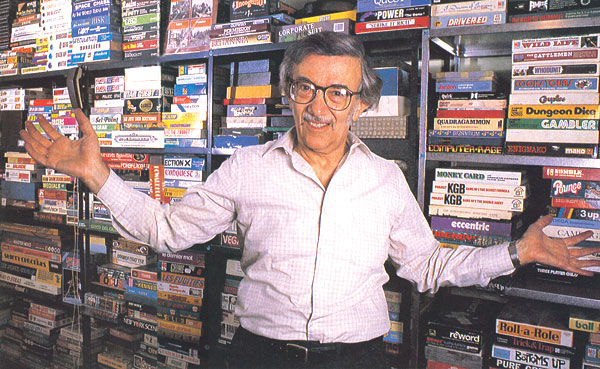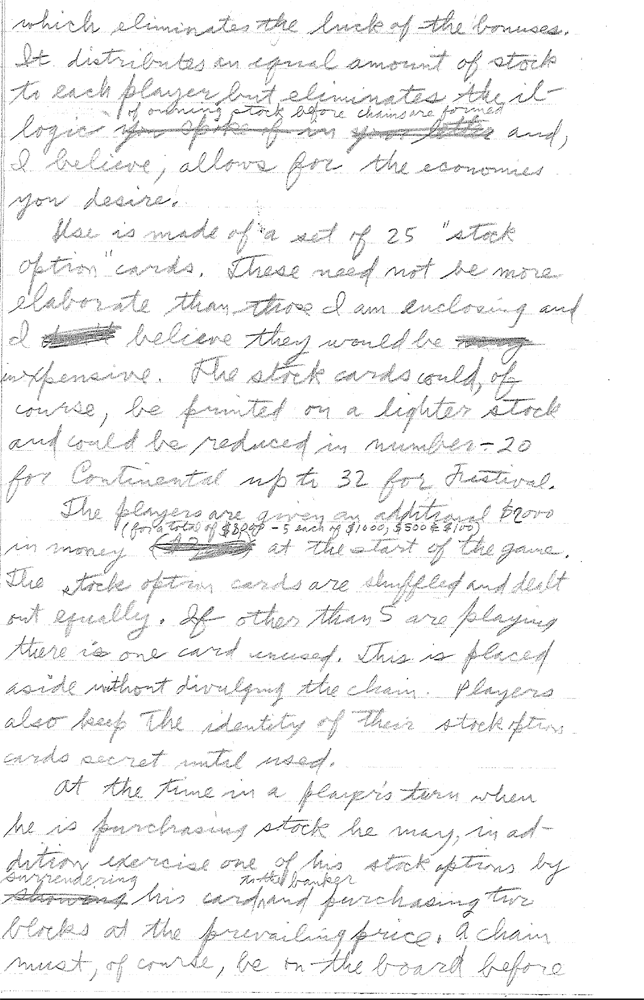"On June 3rd Sid wrote a letter to Bill Caruson in which he talks about his attempts at playing with the bonus for founding. He then tries to sell his next idea of stock options.
“...to give players the opportunity to fight their way back into the game…I then thought of another idea which eliminates the luck of the bonuses. It distributes an equal amount of stock to each player but eliminates the illogic of owning stock before chains are formed and, I believe, allows for the economies you desire. Use is made of a set of 25 “stock option” cards. These not need be more elaborate than those I am enclosing and I believe they would be inexpensive. The stock cards could, of course, be printed on a lighter stock and could be reduced in number – 20 for Continental up to 32 for Festival. The players are given an additional $2000 in money (For a total of $8,000 – 5 each of $1000, $500, $100) at the start of the game.
"The stock option cards are shuffled and dealt out equally. If other than 5 are playing there is one card unused. This is placed aside without divulging the chain. Players also keep the identity of their stock option cards secret until used. At the time in a players turn when he is purchasing stock he may, in addition exercise one of his stock options by surrendering his card to the banker and purchase two blocks at the prevailing price. A chain must, of course, be on the board before stock can be bought in it.
"Since the secret stock option cards introduce an element of uncertainty in themselves, we do not keep the number of stock cards owned secret. For players who have difficulty maintaining a neat pile, this is a welcome change. This method of playing has tested out perfectly in many games and I believe overcomes all the drawbacks of the other versions. I am very anxious to hear your opinion.”
Sid’s efforts were an attempt to try to keep the mystery and strategy in the game and minimize the luck. Yet one idea he was proposing caused more luck when he states that the idea of stock options “eliminates the luck of the bonuses.” If stock options are created to eliminate the luck of the bonuses, then why create the bonuses? Things were moving so fast that thinking was not at its clearest moments. Sid was trying to fix the changes made by 3M by using the method of addition by addition. This was a classic example of a need for addition by subtraction. Since 3M had eliminated the distribution of stocks before game play, then they also needed to eliminate the 2-for-1 trade during game play. Sid’s original idea needed to balance out. If one illogical rule is erased from the original idea, then the other needs to be eliminated to preserve the greatness of the original idea.
In this same letter of June 3rd, Sid tried to erase the illogical thinking of giving free shares before opening, but still keep the semblance of mystery and balance by replacing them with stock options. Since these stock options weren’t going to be free, he decided to give each player more money at the beginning to help pay for those stock options. Yet his method still called for the “shuffle” of the stock options. He tried to sell the idea of keeping the shuffle by claiming they could be printed on cheaper material. 3M already had their mind set on not shuffling any cards because they ultimately didn’t want to pay for the wax coating on the cards. This meant that no matter how hard Sid tried to sell his idea of stock options, 3M wasn’t listening. Well, they did ultimately listen to some of his ideas.
Sid still fights to sway them in this same letter by suggesting chipboard tiles instead of the wood tiles that were used by 3M.
“In the interest of economy, have you seriously considered using pressed board, or even cardboard, for the tiles and reintroducing racks to hold them.”
Sid then proceeds to make a pitch for tile racks even if they don’t change to chipboard tiles. It is interesting that he is trying to make a pitch to save his stock options, by reducing the costs of the tiles, but then suggests another production cost for racks that wipes out the savings of the tiles. 3M’s economy was based on the fact that the same wood tiles could be used in three different games. Sid’s world map idea needed to fit into their idea of mass production.
This letter was written to Caruson on June 3rd. From that point, there was only one entry in the diary about an advertisement for ACQUIRE and no correspondence with 3M until July 30th. This was a span of almost two months. Sid never wrote about it, but he must have been on pins and needles. Especially after the 2nd quarter report came out on July 20th. It showed that sales of ACQUIRE had fallen to $191.72 with Sid’s 5% at $9.59.
This figure seems almost impossible after three months of sales in large department stores, even if it was only in eight major cities. It tends to imply that either 3M was manipulating the figures or they had seriously under stocked the inventory in stores. This thinking is further amplified after the third quarter figures are released. If Sid was disappointed in January with December’s sales, imagine how he must have been feeling at this point.
On July 30th, Caruson sent a letter to Sid.
“I must apologize for not acknowledging your letter of June 3 in which you forwarded several suggested changes for ACQUIRE. The only reason I have not done so until now is that we wanted to try your ideas out on test panels, who have been playing games for us all summer. You will be happy to learn that the over-all reaction of these groups, as far as ACQUIRE is concerned, is that it is one of the best games they have ever played. This has also been confirmed by the consumer reports we have received from people who have actually purchased ACQUIRE. Quite frankly, the basic concept of your game is so sound it doesn’t seem to make too much difference what we do to change the rules to make the game more interesting. However, after much play of several different versions, we have arrived at what we think, and what we are sure you will think, is a real good game. Incidentally, this is not much different than your original game concept.”
3M had decided on the final version of Sid’s idea and they were sending him the set of rules. They settled on their choice, with no communication with Sid, yet they were convinced Sid would like their decision also. What choice did Sid have at this point? There were no choices addressed in this letter because “it doesn’t seem to make too much difference what we do to change the rules to make the game more interesting.” This is the version they were going to market. Sid’s vision of VACATION is now their version of ACQUIRE.






